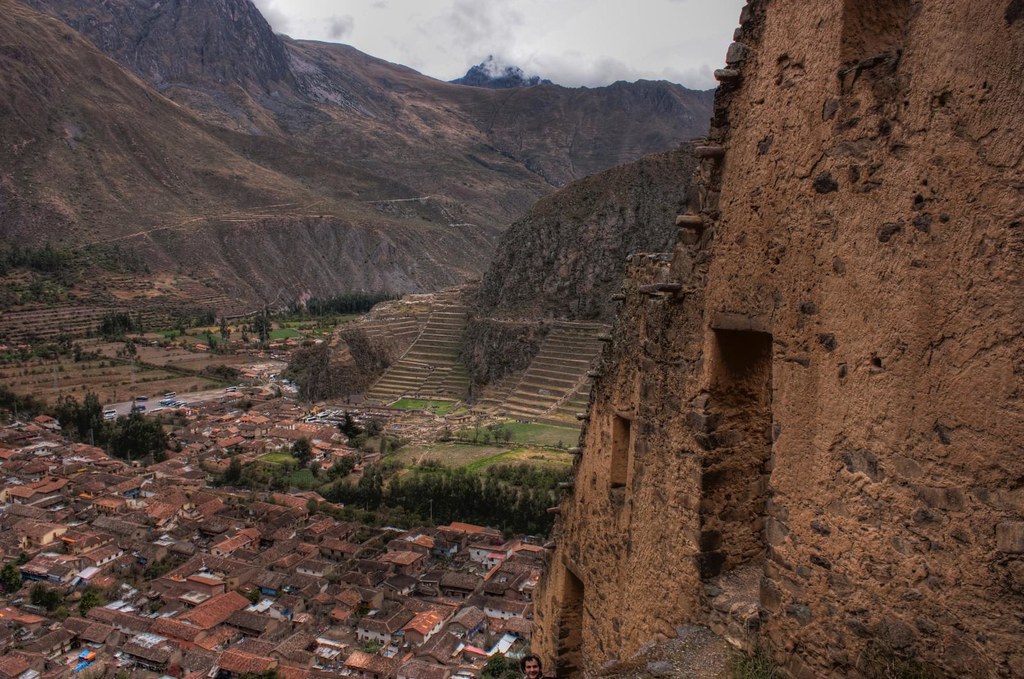I highly recommend taking a cab to Ollantaytambo from Cuzco to get to the train that takes you to Aguas Calientes. Traveling this route provides more insight on how Peruvians live and what natural features they utilize. There are more Inca ruins than just Machu Picchu!
Inca Ruins
The staff at WalkOn Inn had found us a cab to take us to some sights before our final destination. We were unsure about this option because we did not want to pay for more. We were lucky we stumbled onto this option, for we were able to see many more sights we would have overlooked when doing our travel research.
We left most of our luggage at our hostel for our return night from Machu Picchu. Our driver, Ricardo, picked us up and off we went to explore Peru. We drove outside of Cuzco and noticed the conditions of the infrastructure changing. Houses were made of mud and straw with rough roads winding through the desolate, poor parts outside of Cuzco.
Peruvian house
Our first stop was Chincero, which had a church and some vendor stands set up. Chad spent most of our time here negotiating lower prices for some more souvenirs. There was a young boy with the lady Chad was haggling with. He did not talk but would hold up items to try to sell to Chad. What a different culture. The kids definitely start working young!
Souvenirs
Our next stop: Moray. During our drive between Chincero and Moray, Ricardo pulled over a few times to let us take pictures of the views. I got a picture of mud bricks used to make houses.
Brick making
Moray was a farm land with multiple levels of cultivation built on the hill with circles. We walked around and were able to walk to the bottom. To get to the next row (lower or higher), there were steps sticking out of the stop walls. The design was impressive, especially knowing how old the ruins were made without the help of machinery.
Moray
We back-tracked to our next stop: Maras. Maras has salt fields/pools that form naturally from an underground salt lake. I tasted the water from a stream, and it was multiple times stronger than getting a mouth full of ocean water.
Maras
We stopped at Urubamba for lunch for more authentic Peruvian food that Ricardo recommended. After lunch, we continued to Ollantaytambo. We saw snow-capped mountains, along with mountains so high they were hidden by the clouds. We arrived at Ollantaytambo with a few hours to explore before catching our train.
Ollantaytambo
Pinkuylluna are ancient ruins across the town from Temple Hill that were Inca storehouses. We hiked to the ruins instead of paying the entrance fee for Temple Hill.
Pinkuylluna Ruins
From Ollantaytambo, we walked to PeruRail to catch the buses to Piscacucho to catch the train. The buses were substituting the train due to a recent flood that washed out the rails from Ollantaytambo to Piscacucho. Once we arrived at Piscacucho, it was time to go shopping with vendors for souvenirs EVERYWHERE! I bought an alpaca sweater.
Peruvian Market at Picacucho Train Station
We boarded the train after having some beer and coffee in the train station’s cafe. This is where we would meet Jill and Jon McDermid from Canada. We would continue to run into them the remainder of our Machu Picchu experience.
We finally arrived in Aguas Calientes and checked into Hostal Varayoc. Tomorrow, we would be exploring Machu Picchu.
Hostal Varayoc
TIP: Consider buying the Cuzco Tour Pass because we had to pay at some of the stops during our cab drive, which included the ruins at Ollantayabmo.

















